By the early 1950s Fort Worth’s downtown business community referred to 7th Street as the “Canyon” because it was lined with tall commercial buildings: Electric Building (1929), Worth Hotel (1927), Fort Worth Club (1926), Oil and Gas Building (1954), The Fair (1930), Continental National Bank (1956), Fort Worth National Bank (1952), Farmers and Mechanics National Bank (1921), Aviation Building (1930).
But to the movie-going public, 7th Street downtown was “Show Row.”
For forty-one years—from 1930 to 1971—along a five-block stretch of 7th Street stood three cathedrals of cinema—Palace, Worth, and Hollywood—built in an era when a theater was as much a spectacle as the motion pictures it presented, when the likes of John Wayne, Elvis, Fred Astaire, and Kirk Douglas swaggered and sang and danced and dimpled their way across the screen in lavishly appointed theaters that befit the royalty of Hollywood.
The sidewalks of 7th Street bustled on Friday and Saturday nights as people queued at the three ticket booths to see the latest release before it trickled down to the drive-in theaters and neighborhood indoor theaters like the Poly, the Isis, the Bowie.
Palace
The first show on the row could trace its lineage to a time before motion pictures even existed. In 1883 Walter Huffman built the Fort Worth Opera House at the corner of East 3rd and Commerce streets. After Huffman died in 1890 Phil Greenwall bought the opera house from Huffman’s heirs and operated it as “Greenwall’s Opera House.” Greenwall and brother Henry were impresarios in Texas theater, managing a circuit of dozens of theaters across the state, booking live entertainment—stock companies, opera companies, burlesque, and other acts—and later movies.
But in 1908 the opera house was damaged by wind. Architect Marshall Sanguinet advised Phil Greenwall that the building was not worth repairing. Greenwall decided to find someone to finance a replacement building.
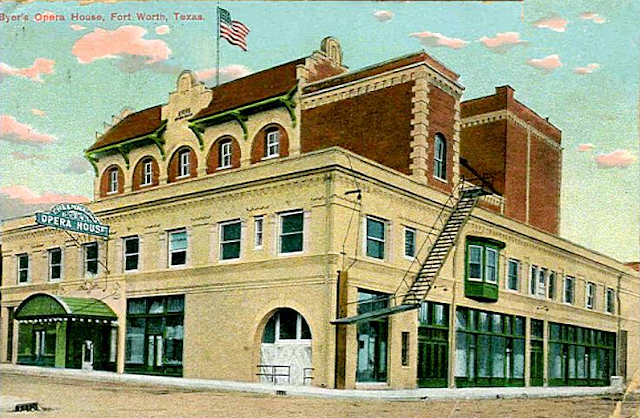 Local capitalist Andrew Thomas Byers financed the new building at East 7th and Commerce streets and leased it to Greenwall. The opera house was known alternately as “Byers’ Opera House” and “Greenwall’s Opera House.”
Local capitalist Andrew Thomas Byers financed the new building at East 7th and Commerce streets and leased it to Greenwall. The opera house was known alternately as “Byers’ Opera House” and “Greenwall’s Opera House.”
It opened in 1908.
As silent movies became more popular, the opera house added movies to its program of live entertainment.
D. W. Griffith’s Birth of a Nation had its Fort Worth premiere at the Byers in 1915.
In 1919 Pierre Levy bought the opera house and converted it into the first theater in town designed to show motion pictures (but it also had a stage “for high-class road attractions”).
Architects Sanguinet and Staats, assisted by Raphael Nicholais, designed the new look. (Nicholais in 1923 would design R. O. Dulaney’s fine house on Elizabeth Boulevard.)
The interior of the theater was enlarged and customized for the motion picture experience. A new organ was installed. The theater would have a resident orchestra and conductor.
Levy sold the remodeled building to E. H. Hulsey of Dallas. Hulsey owned several theaters.
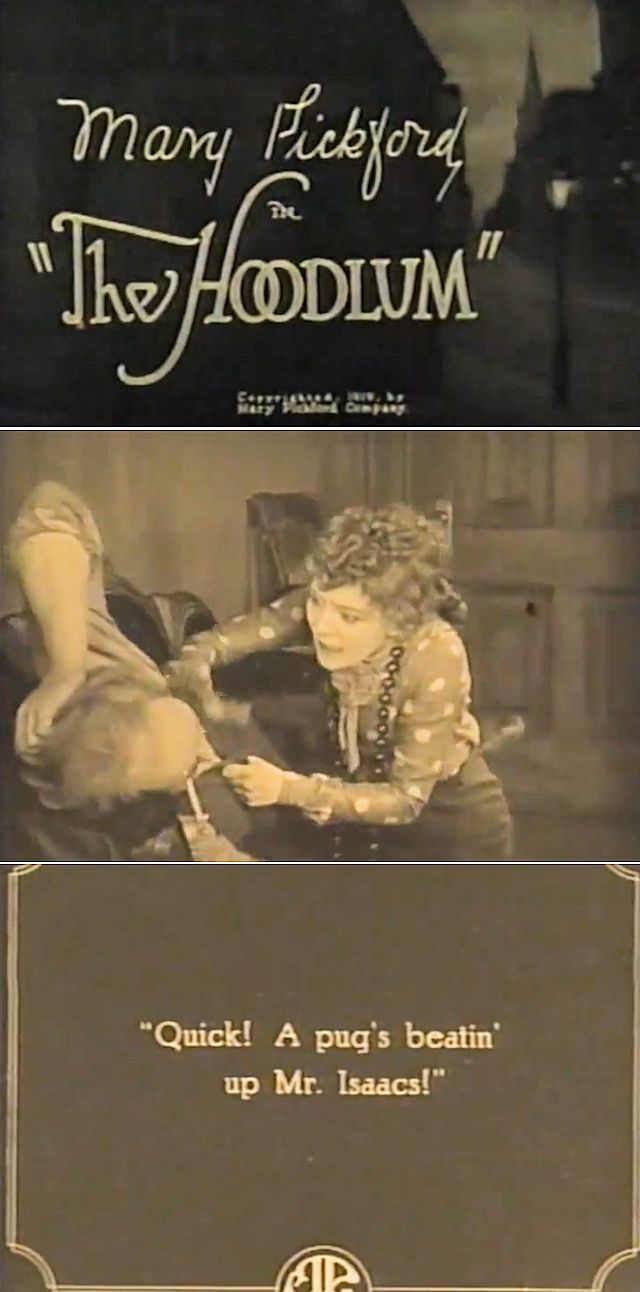 The Palace Theater opened on October 19, 1919 with The Hoodlum starring Mary Pickford.
The Palace Theater opened on October 19, 1919 with The Hoodlum starring Mary Pickford.
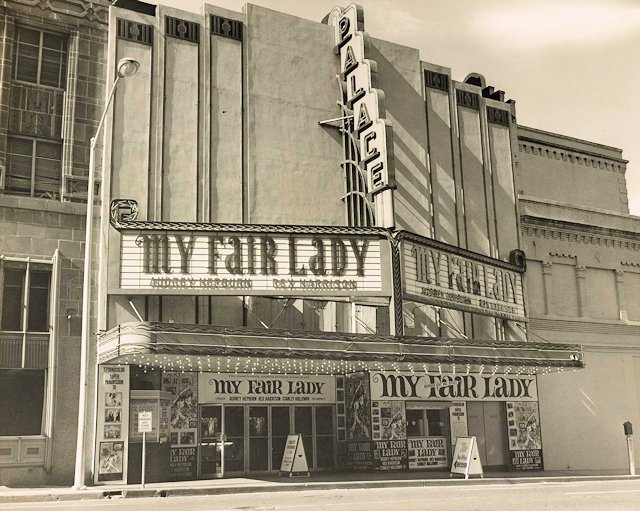 This photo shows how much the façade of the original theater had changed by 1964. The marquee was topped by the word PALACE in letters bright and large enough to be seen from the ticket queues at the Hollywood and Worth theaters at the other end of Show Row.
This photo shows how much the façade of the original theater had changed by 1964. The marquee was topped by the word PALACE in letters bright and large enough to be seen from the ticket queues at the Hollywood and Worth theaters at the other end of Show Row.
But to the right of the marquee can be seen some of the original brick detailing of the 1908 facade. (Photo from UNT Media Library.)
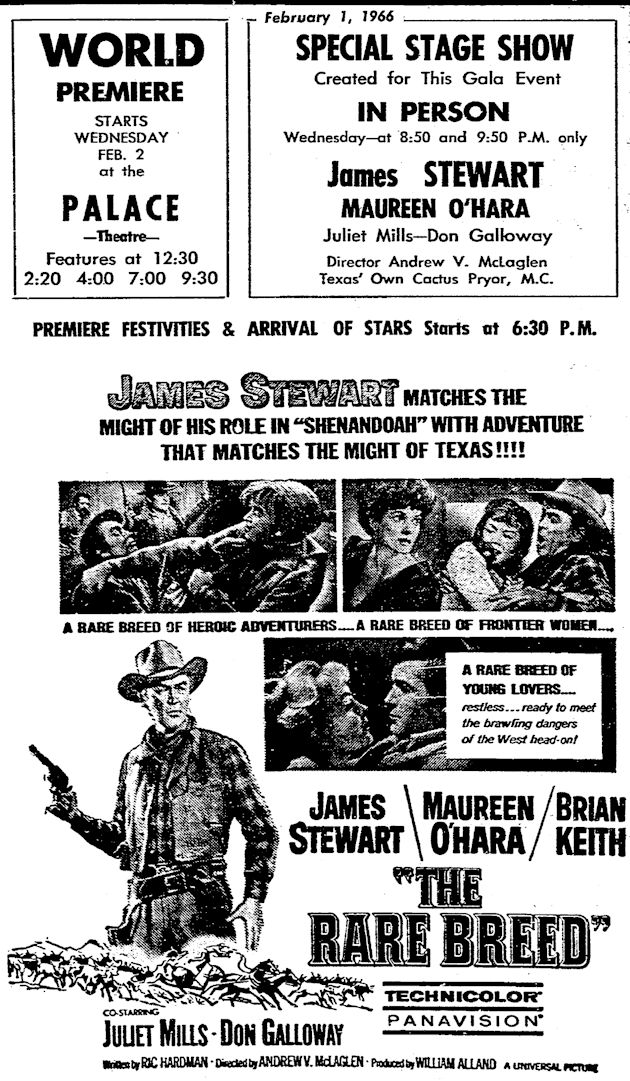 Jimmy Stewart and Maureen O’Hara made a personal appearance at the Palace in 1966 to promote The Rare Breed.
Jimmy Stewart and Maureen O’Hara made a personal appearance at the Palace in 1966 to promote The Rare Breed.
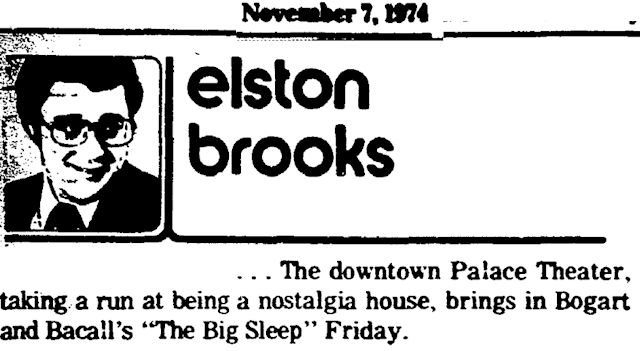 But the 1970s were not kind to Show Row. In 1974 the ABC Interstate Theaters chain, which owned the Palace, Wedgwood, Ridglea, Arlington, Belaire, and 7th Street theaters and the Mansfield Drive-In theater, planned to close the Palace. But local businessman John O’Hara bought the Palace, hoping to keep the projectors turning by showing classic movies.
But the 1970s were not kind to Show Row. In 1974 the ABC Interstate Theaters chain, which owned the Palace, Wedgwood, Ridglea, Arlington, Belaire, and 7th Street theaters and the Mansfield Drive-In theater, planned to close the Palace. But local businessman John O’Hara bought the Palace, hoping to keep the projectors turning by showing classic movies.
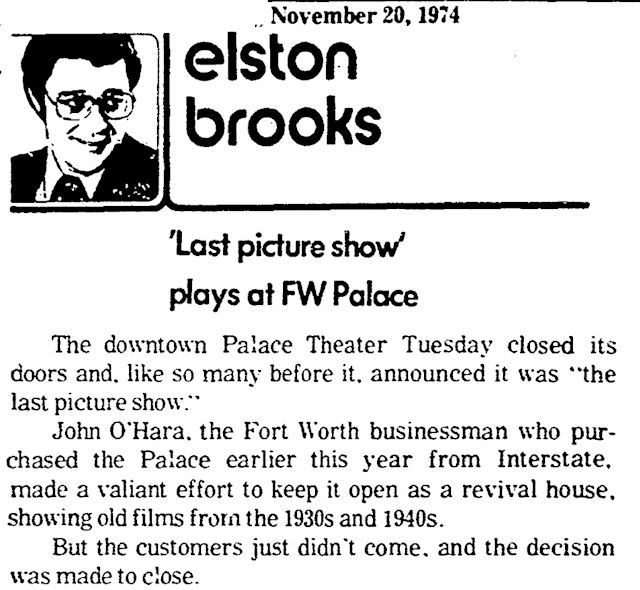 But for the Palace, The Big Sleep was the last picture show. The theater closed in November 1974.
But for the Palace, The Big Sleep was the last picture show. The theater closed in November 1974.
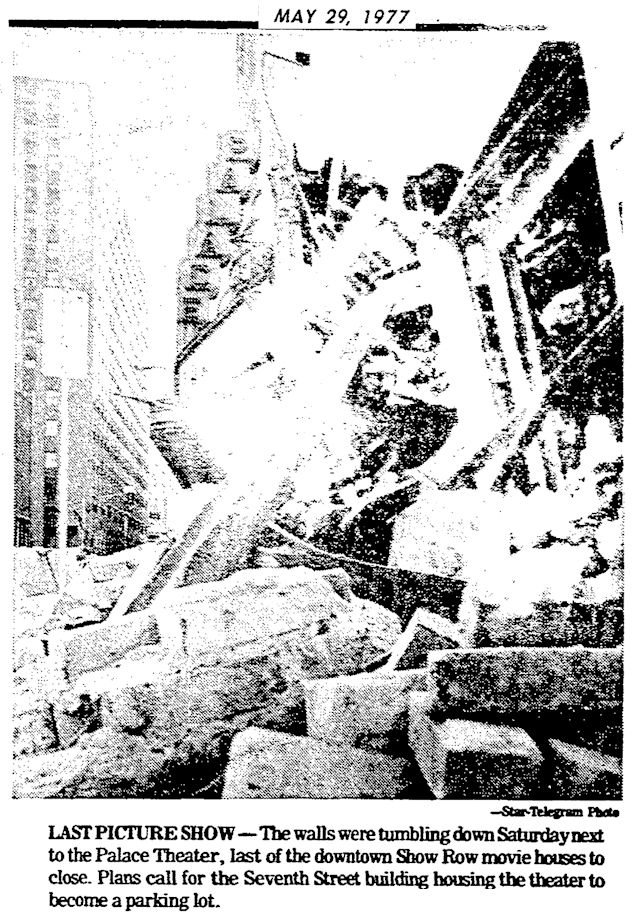 The Palace Theater building was torn down in 1977, replaced by a parking lot. In 1982 the parking lot yielded to the forty-story Carter-Burgess Plaza building (now the UMB Bank Building).
The Palace Theater building was torn down in 1977, replaced by a parking lot. In 1982 the parking lot yielded to the forty-story Carter-Burgess Plaza building (now the UMB Bank Building).
But the Palace Theater light shines on:
Burn Brightly, Eternal Light
Worth
 On November 26, 1927 the Palace got its first sibling—and its first competition—when the Worth Theater opened.
On November 26, 1927 the Palace got its first sibling—and its first competition—when the Worth Theater opened.
 The Worth Theater was located in the Worth Hotel. (W. D. Smith photo in Fort Worth in Pictures.)
The Worth Theater was located in the Worth Hotel. (W. D. Smith photo in Fort Worth in Pictures.)
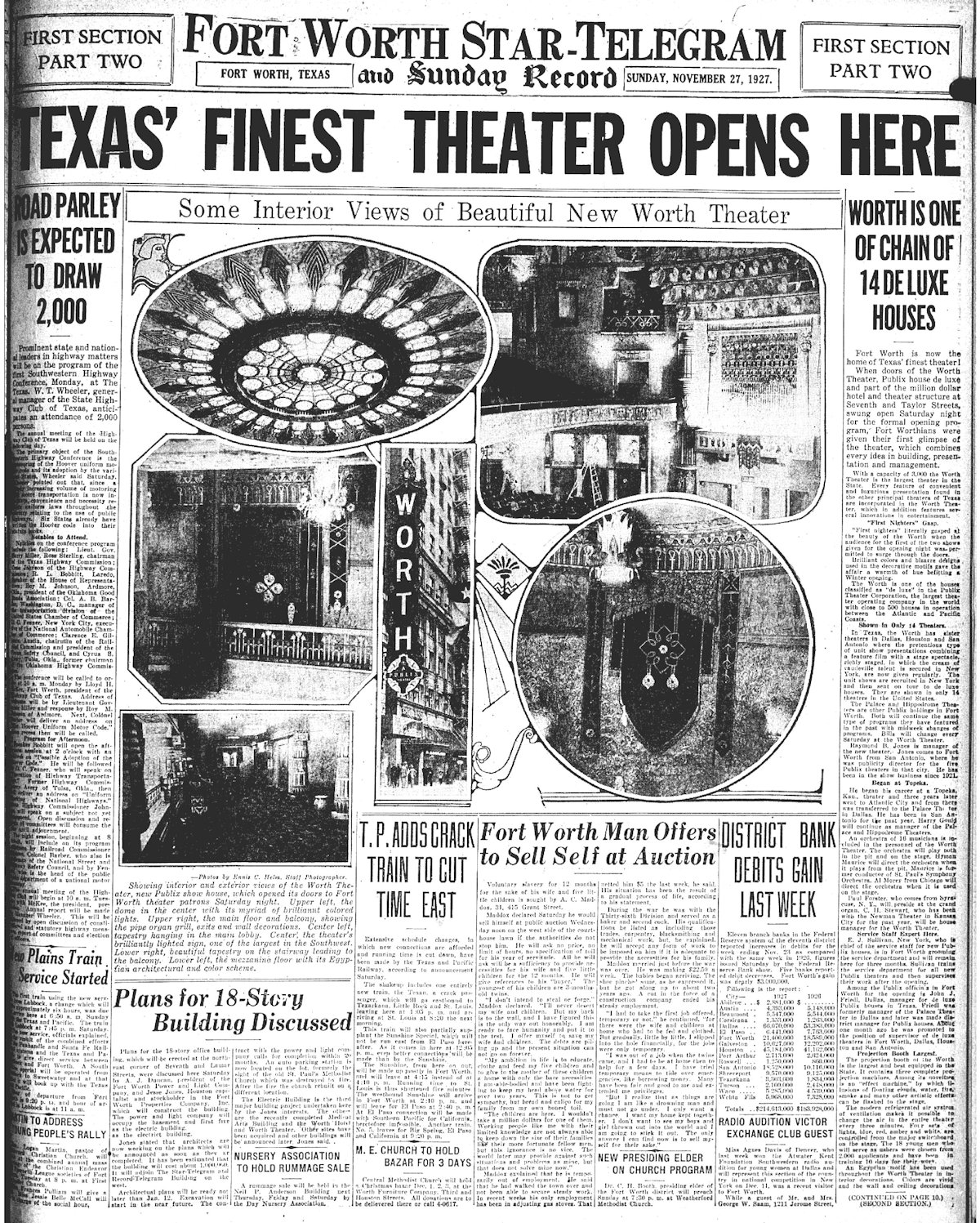 The Worth proclaimed itself to be “Texas’ finest theater.”
The Worth proclaimed itself to be “Texas’ finest theater.”
“‘First nighters’ literally gasped at the beauty” of the new theater, the Star-Telegram reported that day. The Egyptian motif featured deities, tapestries, friezes, pillars with lotus-blossom capitals. The theater’s capacity—three thousand (but only 2,284 seats)—was the largest in the state.
The Worth building was financed by capitalist Jesse Jones of Houston and designed by architect Wyatt C. Hedrick.
Special attractions of the Worth Theater were its Worth Grand Orchestra and its mighty Wurlitzer pipe organ, played between features by Billy Muth until his death in 1949.
 Through the years the Worth Theater premiered movies about local subjects: Edna Gladney, Consolidated Aircraft, Vernon Castle.
Through the years the Worth Theater premiered movies about local subjects: Edna Gladney, Consolidated Aircraft, Vernon Castle.
 Stars who appeared at the Worth Theater to promote their new movies included Abbott and Costello, Gary Cooper, Gregory Peck, and John Wayne.
Stars who appeared at the Worth Theater to promote their new movies included Abbott and Costello, Gary Cooper, Gregory Peck, and John Wayne.
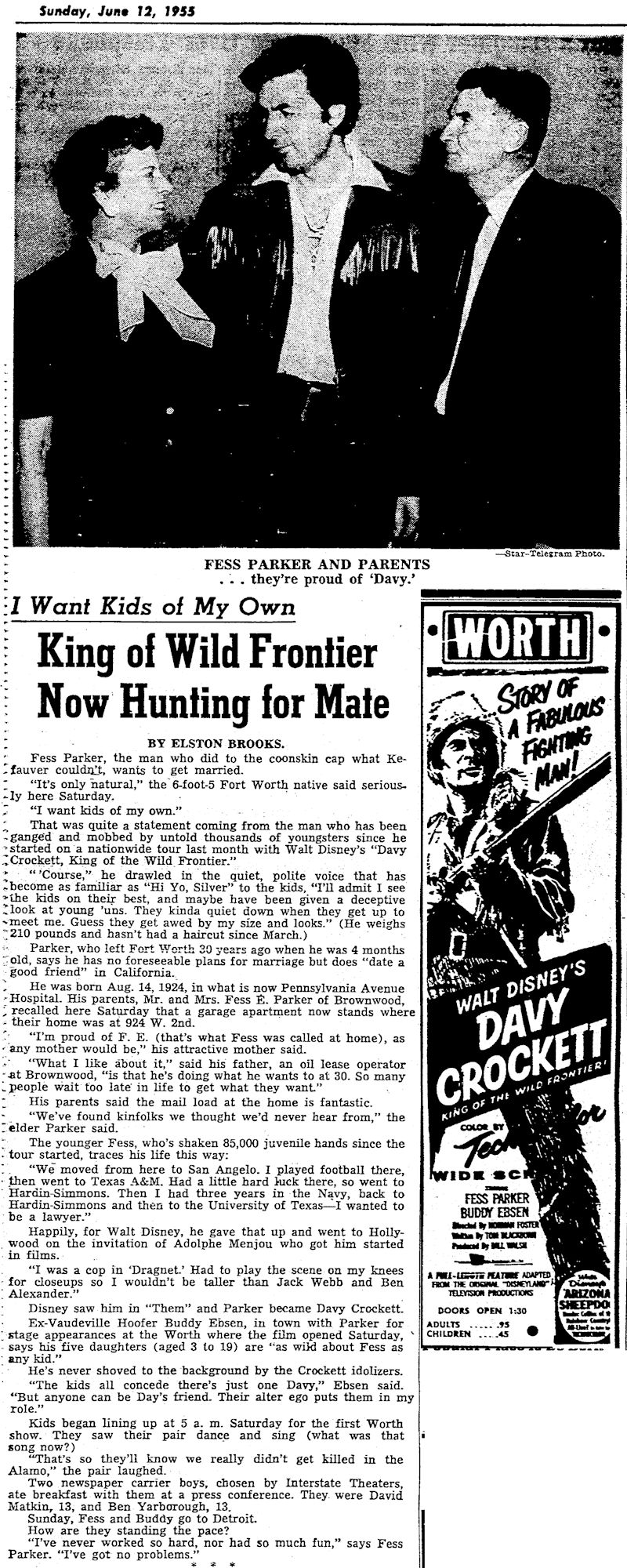 Oh, and “born on a mountain top in old Cowtown” Fess Parker, who was back home in 1955 to appear at the Worth Theater with sidekick Buddy Ebsen during the height of the Davy Crockett craze.
Oh, and “born on a mountain top in old Cowtown” Fess Parker, who was back home in 1955 to appear at the Worth Theater with sidekick Buddy Ebsen during the height of the Davy Crockett craze.
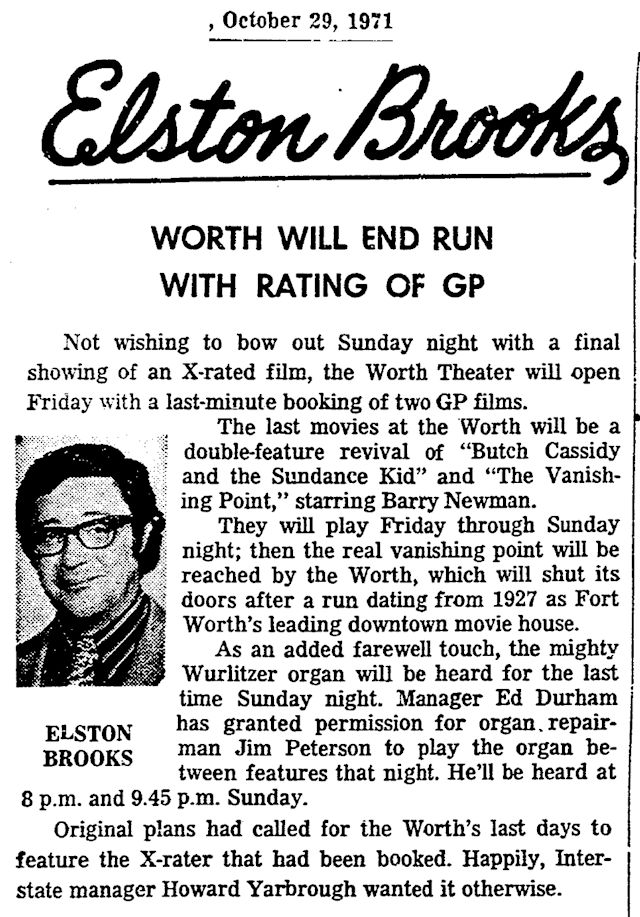 But in October 1971 the Worth Theater presented its last movies, a double bill of Butch Cassidy and The Vanishing Point.
But in October 1971 the Worth Theater presented its last movies, a double bill of Butch Cassidy and The Vanishing Point.
 October 31, 1971 was the last time the Star-Telegram printed ads for all three theaters.
October 31, 1971 was the last time the Star-Telegram printed ads for all three theaters.
With the closing of the Worth Theater, Show Row was reduced from triplets to twins.
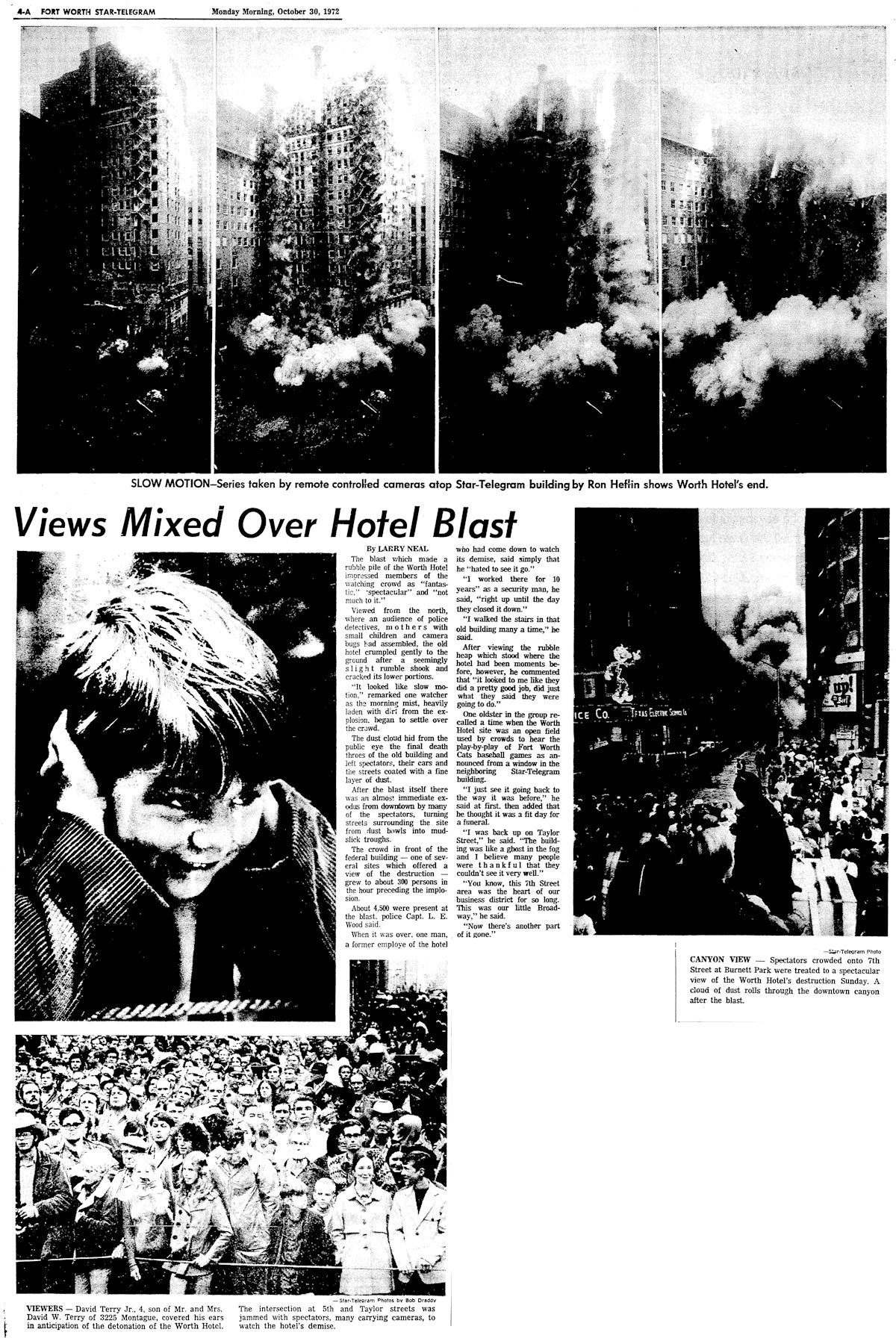
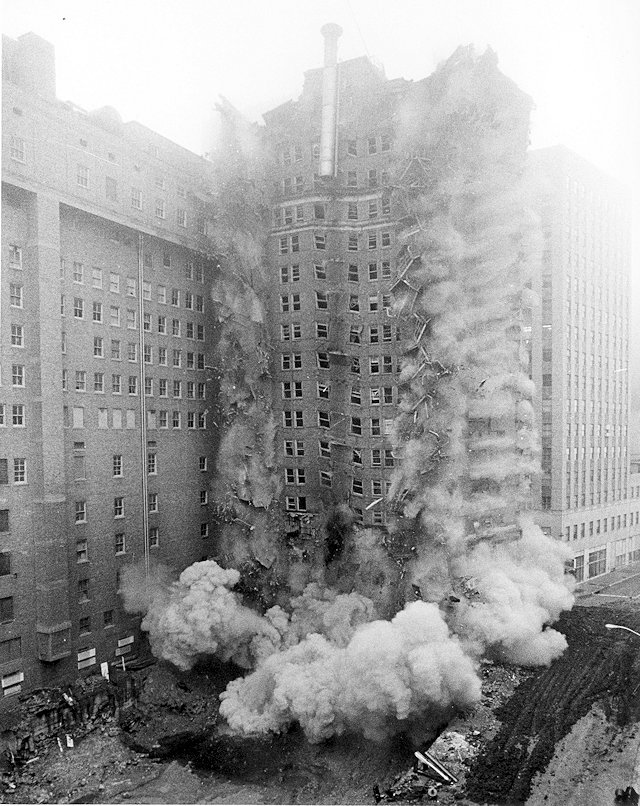 Curtains for the Worth Hotel/Worth Theater building came on October 29, 1972. (Photo from Jack White Photograph Collection, University of Texas at Arlington Libraries.)
Curtains for the Worth Hotel/Worth Theater building came on October 29, 1972. (Photo from Jack White Photograph Collection, University of Texas at Arlington Libraries.)
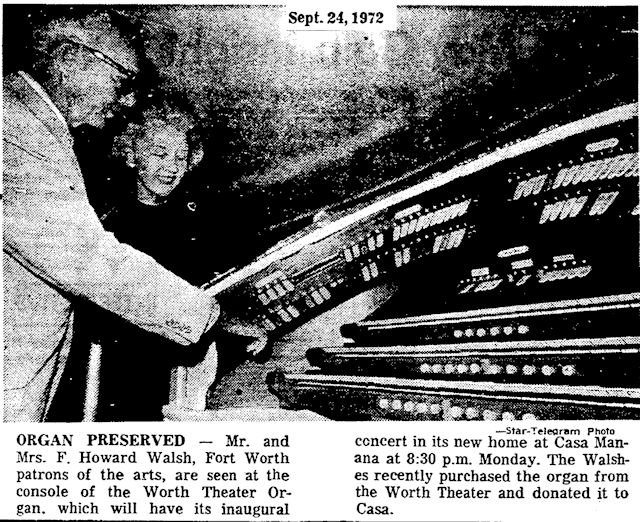 But the theater’s mighty Wurlitzer pipe organ found a new home at Casa Manana, thanks to Mr. and Mrs. F. Howard Walsh.
But the theater’s mighty Wurlitzer pipe organ found a new home at Casa Manana, thanks to Mr. and Mrs. F. Howard Walsh.
Hollywood
Show Row reached its full complement of three on April 17, 1930 when the Hollywood Theater opened in the Electric Building.
The Electric Building/Hollywood Theater was another Jesse Jones project. In addition to the two theaters, Jones built the Medical Arts Building (1927) and The Fair. Like the Worth Hotel, the Electric Building was designed by Wyatt Hedrick.
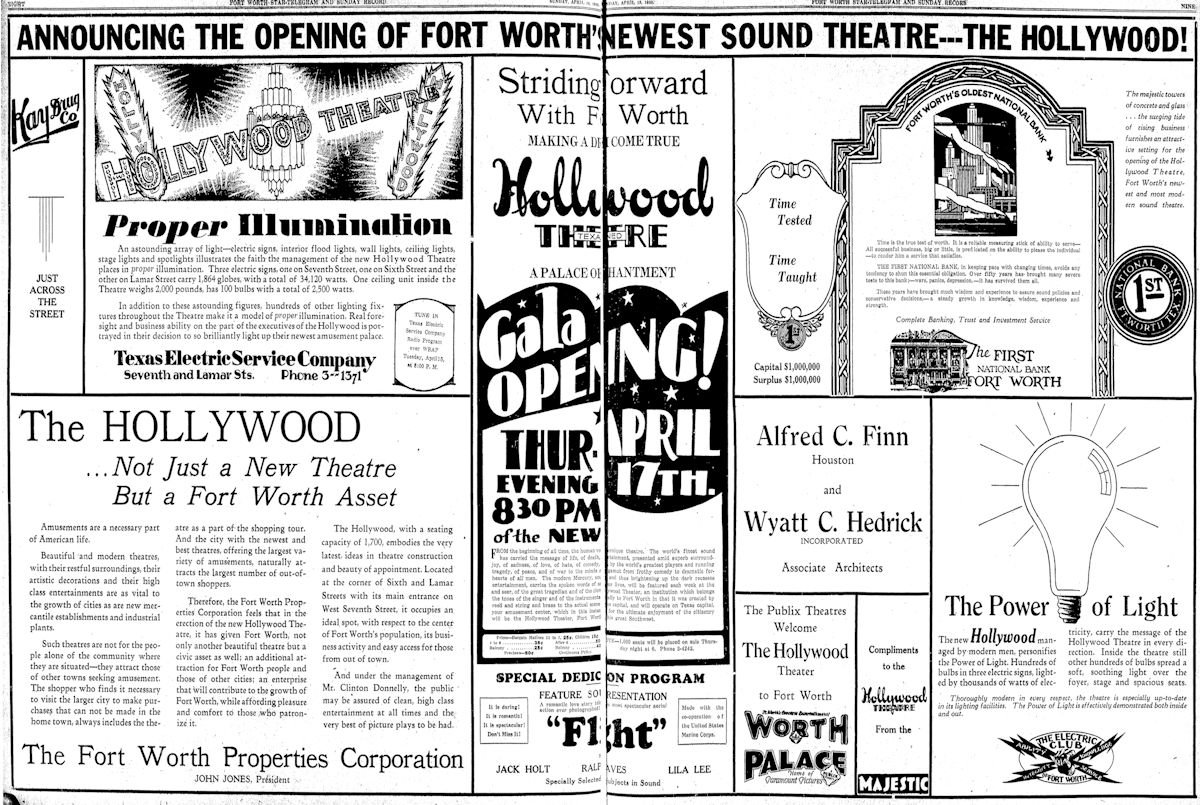 On April 13, 1930 the Star-Telegram printed a two-page spread on the opening of the “palace of enchantment.”
On April 13, 1930 the Star-Telegram printed a two-page spread on the opening of the “palace of enchantment.”
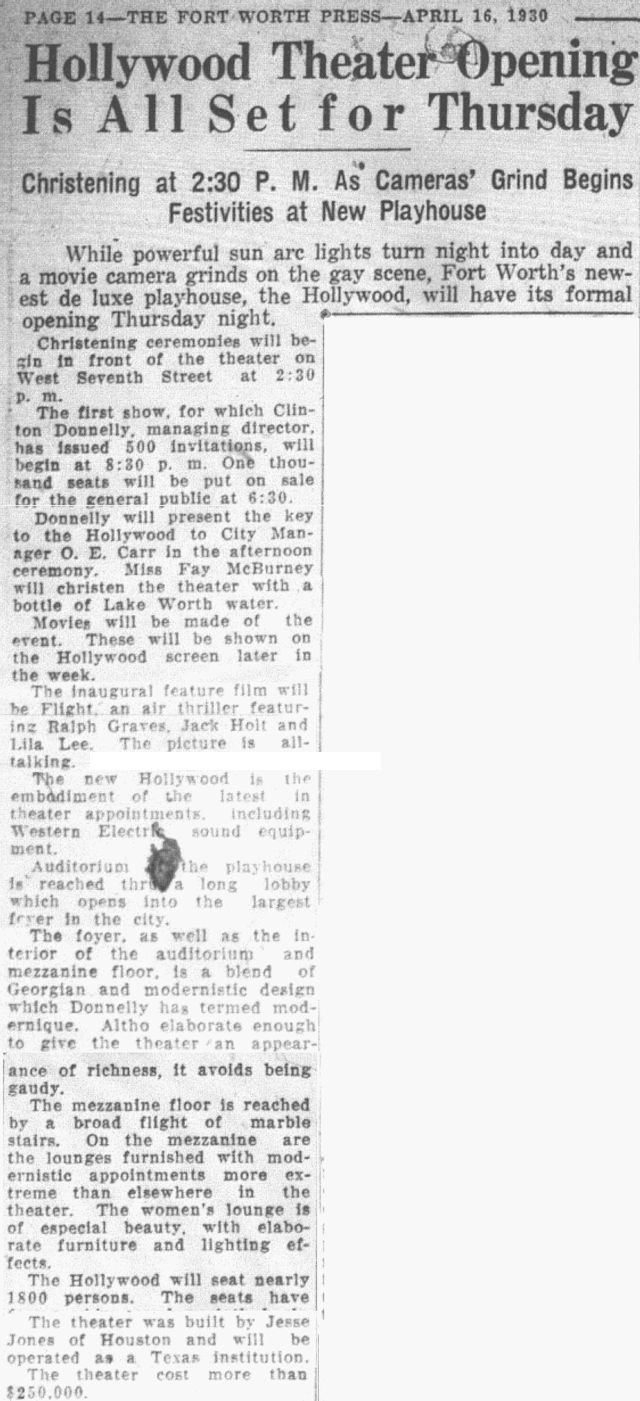 The Fort Worth Press wrote: “The foyer, as well as the interior of the auditorium and mezzanine floor, is a blend of Georgian and modernistic design. Although elaborate enough to give the theater an appearance of richness, it avoids being gaudy. The mezzanine floor is reached by a broad flight of marble stairs. On the mezzanine are the lounges furnished with modernizing appointments more extreme than elsewhere in the theater. The women’s lounge is of especial beauty, with elaborate furniture and lighting effects.
The Fort Worth Press wrote: “The foyer, as well as the interior of the auditorium and mezzanine floor, is a blend of Georgian and modernistic design. Although elaborate enough to give the theater an appearance of richness, it avoids being gaudy. The mezzanine floor is reached by a broad flight of marble stairs. On the mezzanine are the lounges furnished with modernizing appointments more extreme than elsewhere in the theater. The women’s lounge is of especial beauty, with elaborate furniture and lighting effects.
“The Hollywood will seat nearly 1,800 persons.”
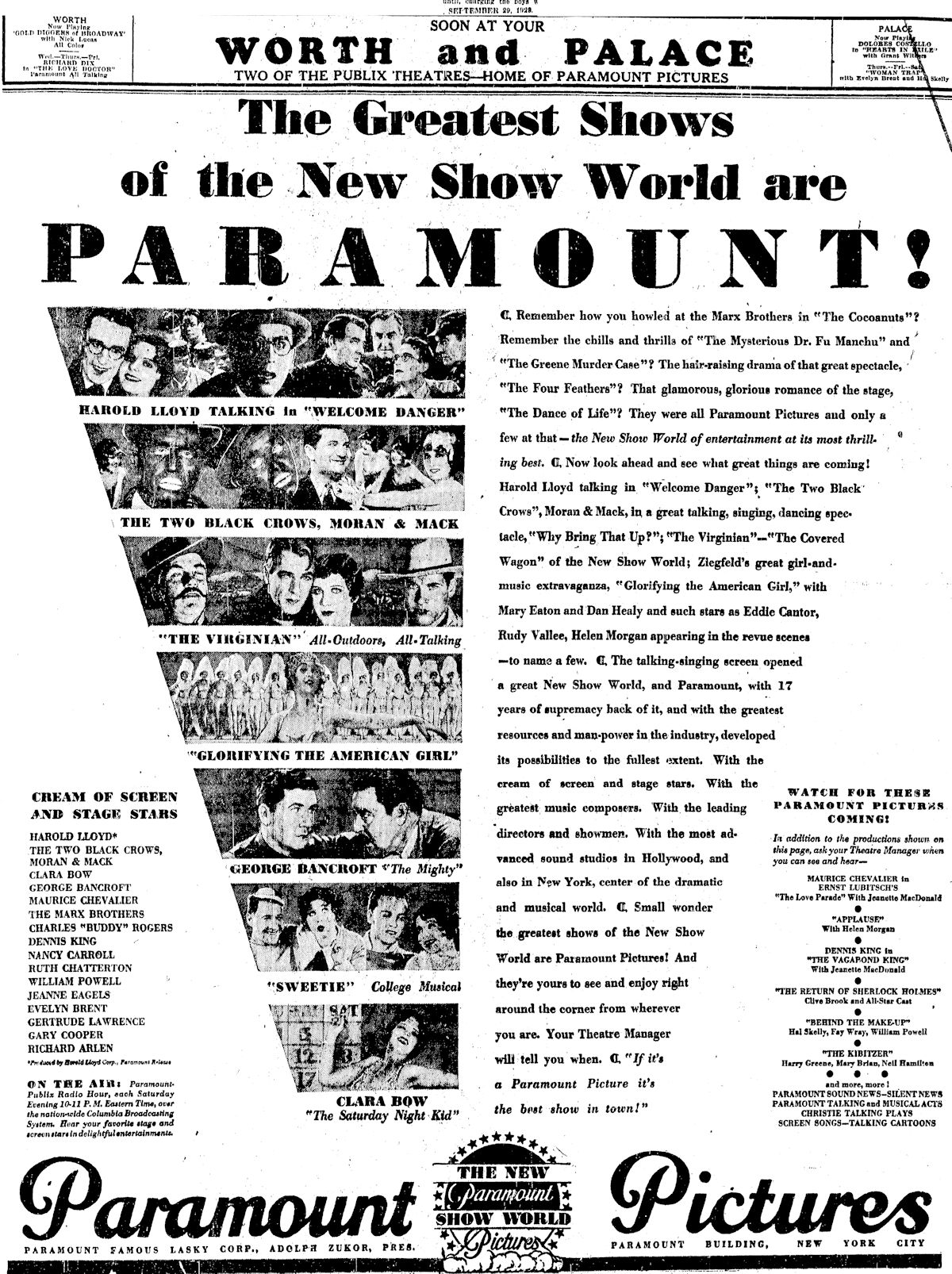
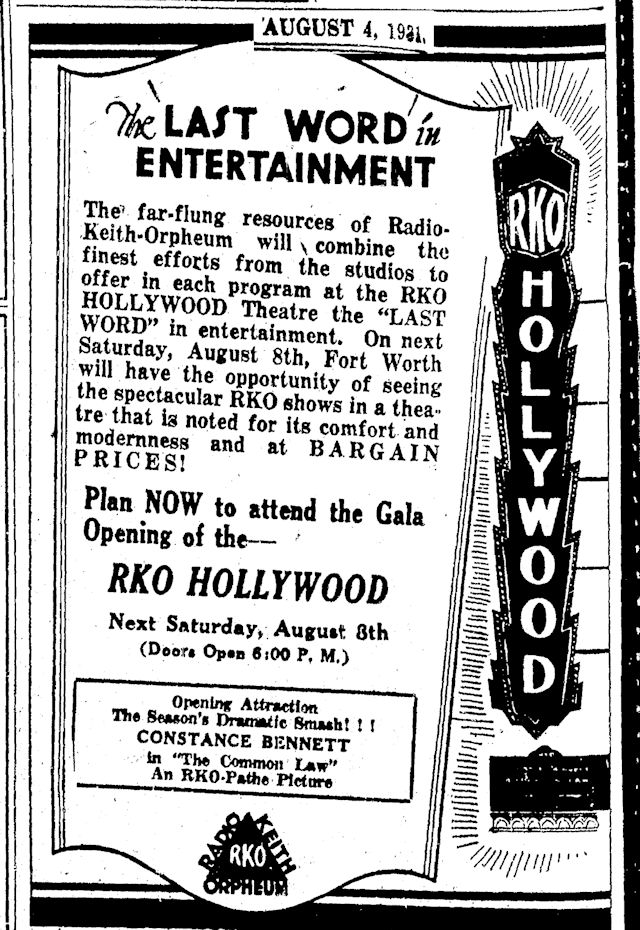 The Worth and Palace early on were part of Paramount’s Publix theater chain. The Hollywood in 1931 joined the RKO chain.
The Worth and Palace early on were part of Paramount’s Publix theater chain. The Hollywood in 1931 joined the RKO chain.
 By 1940 all three theaters were part of the Interstate chain. (W. D. Smith photo in Fort Worth in Pictures.)
By 1940 all three theaters were part of the Interstate chain. (W. D. Smith photo in Fort Worth in Pictures.)
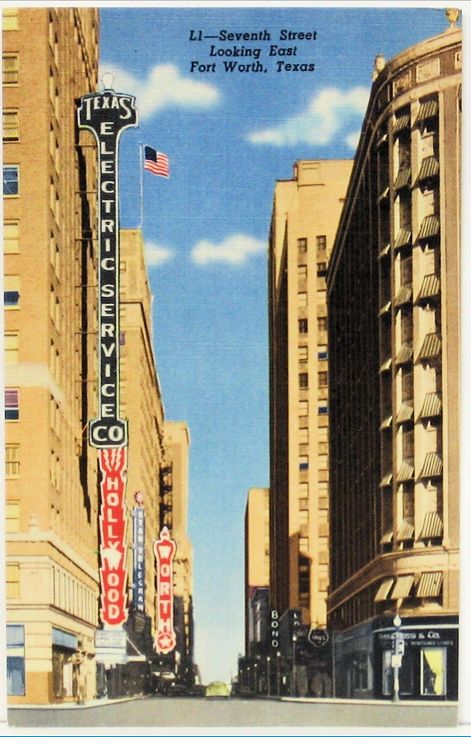 Two out of three: the Hollywood and Worth. Out of view on East 7th at Commerce Street was the Palace.
Two out of three: the Hollywood and Worth. Out of view on East 7th at Commerce Street was the Palace.
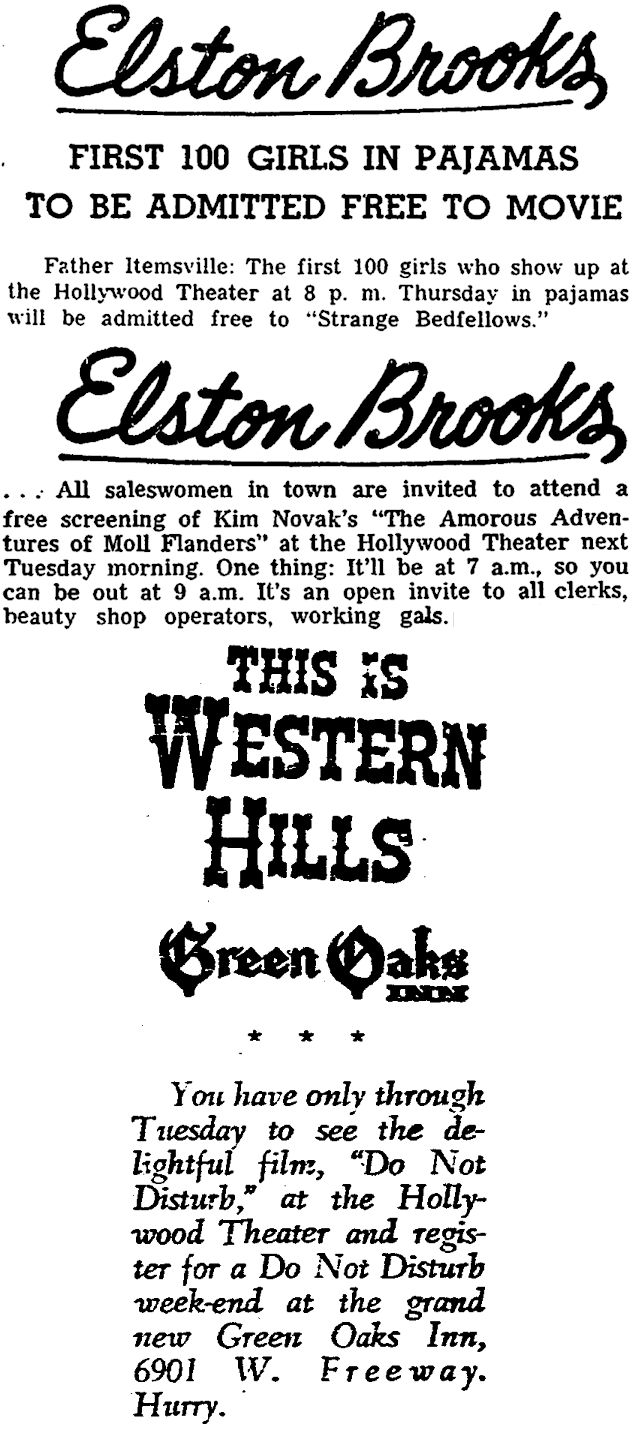 The managers of the Hollywood were masters of publicity.
The managers of the Hollywood were masters of publicity.
 But in October 1976 Majestic Theatres, the company that had leased the Hollywood Theater for three years, announced that it had lost its lease and would close the theater, which was then showing “films appealing predominately to black audiences.”
But in October 1976 Majestic Theatres, the company that had leased the Hollywood Theater for three years, announced that it had lost its lease and would close the theater, which was then showing “films appealing predominately to black audiences.”
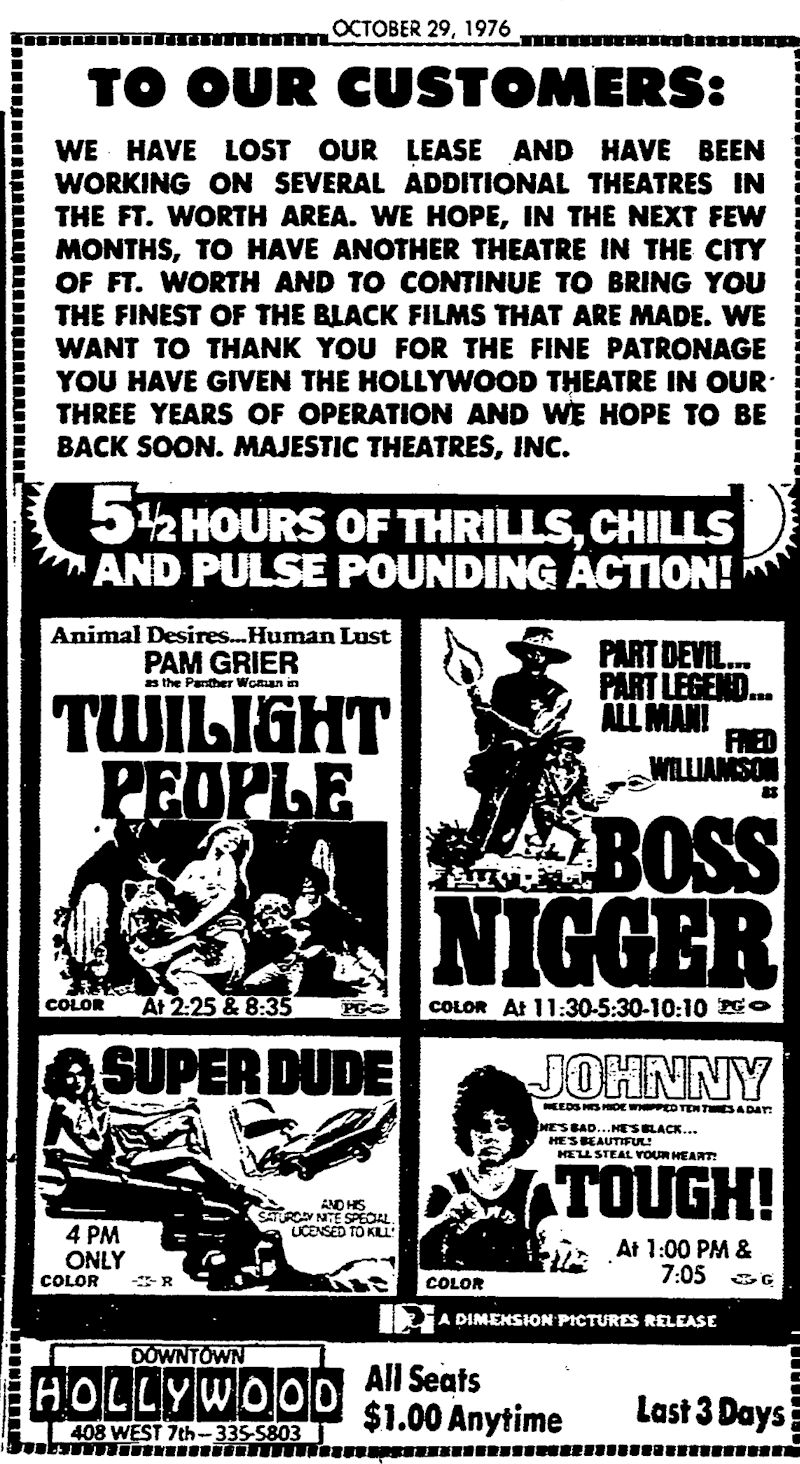 The Hollywood closed at the end of October.
The Hollywood closed at the end of October.
With the closing of the Hollywood Theater, Show Row—after bringing drama, romance, adventure, and comedy to Fort Worth for thirty-one years—went dark.
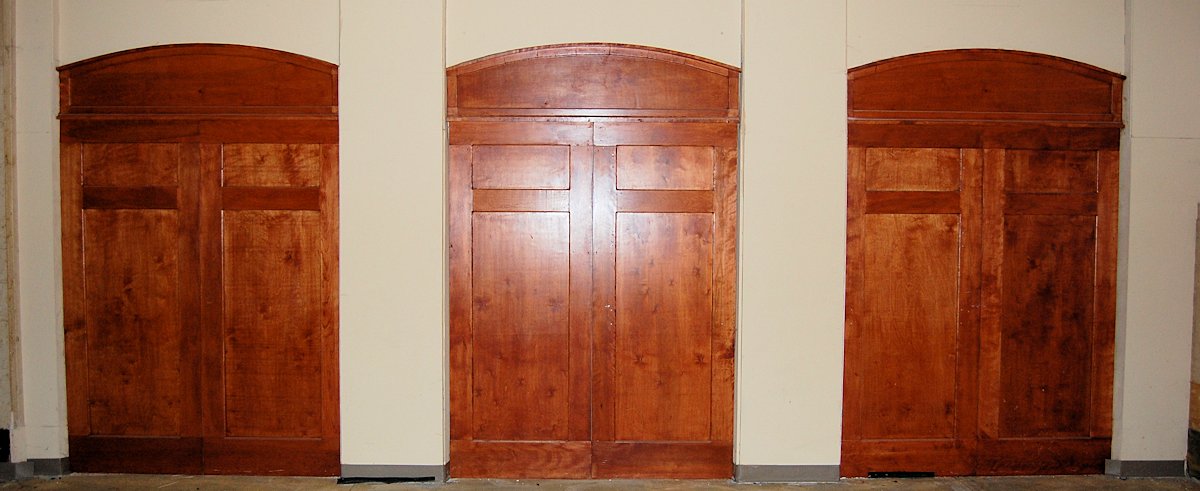 The Electric Building was converted into apartments, but within its walls the Hollywood Theater’s stage, canopy, foyer, hallway, lobby space, balcony stairs, six hundred seats of the auditorium, and these auditorium doors survive.
The Electric Building was converted into apartments, but within its walls the Hollywood Theater’s stage, canopy, foyer, hallway, lobby space, balcony stairs, six hundred seats of the auditorium, and these auditorium doors survive.





